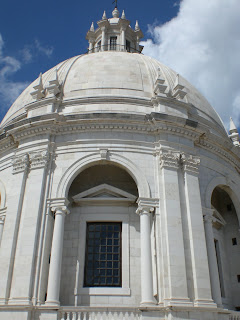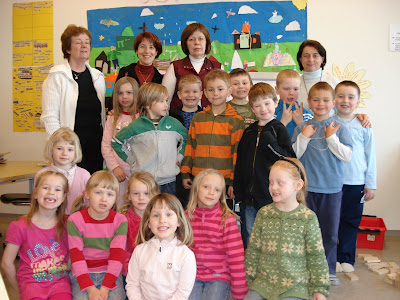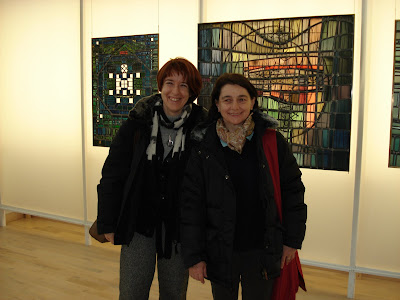Mynd 2: Vinalegar teikningar barnanna taka á móti gestum í portúgalska skólanum.
Mynd 3: Brúðurnar sem Portúgölsku krakkarnir gerðu við íslensku þjóðsöguna "Trunt, trunt og tröllin í fjöllunum"
Mynd 4: Ítalirnir gerður brúður við finnska þjóðsögu en við Íslendingarnir sömdum texta við hann og hét sagan þá "Eyjan" ATH: Íslenskur texti er neðst á síðunni
Last week, April 21-23, Tales of Europe held a project meeting in Lisbon, where representatives of Patricio Prazeres school had prepaired a warm welcome. The program included work and pleasure, the pleasure being both with the administration of the city district and also with the pupils and teachers of the school.
I will write more about the things that we learned about the Portuguese school later, the only thing I wish to say now is that we felt we had friends there.
The meeting proper started by the representatives telling each other what their pupils had done during the school-year and showing the puppets that their pupils had made with the circling folktale (joint activity of the year). After that there were discussions about the evaluation and a joint wording agreed to. - The partners have set themselves certain goals within the project and each year we compare the aims and the real results. Most of the goals had been reached, but we all felt that next year we should use more time for studying the material the partners have sent to each other and also that each school should use more time for studying their own material.
It was decided to stick to the existing plan of studying seasonal stories next school-year. These tales shall be made in a book form. Also we decided to use ordinary mail and involve our pupils in folding game, which will be used to learn words in all the four languages. Additionally it was decided to collect all the songs of the project on one cd. The circling folktales (joint activity) shall return to its origin where the new tale will be dramatized by pupils compising the actual words.
Next project meeting will be in Digranes School in Iceland in Ocotber, 22-24, 2008. The final meeting between partners will be in Tammisaari, Finland, in May 2009.
There is a lot to write about the meeting in Lisbon and about our hosts, the Portuguese, so please, do have a look at the page also later, more text and more photos will be found here.
Marjatta, project coordinator (from Digranesskóli, Iceland)
Matsfundur vegna verkefnisins Tales of Europe var í Lissabon dagana 21.-23. apríl og sátu þann fund fjórir fulltrúar Digranesskóla, þær Hildur Árnadóttir deildarstjóri yngsta stigs, Þórdís Sævarsdóttir tónlistarkennari, Þórlaug Arnsteinsdóttirumsjónarkennari 1.Þ. og Marjatta Ísberg verkefnisstjóri.
Við fengum höfðingjalegar móttökur í Lissabon. bæði af hálfu borgaryfirvalda og skólans. Fyrsta daginn bauð okkur inn til sín Joaquim Pires, borgarstjóri St Engracia hverfisins (en Lissabon er skipt í fleiri hverfi með hvert sinn borgarstjóra og -stjórn sem er kosin á fjögurra ára fresti), þar sem vinaskólinn okkar er. Þar var okkur sýnt hvers konar þjónustu borgin veitir íbúum sínum. Í skólanum var móttökuhátíð þar sem nemendur sýndu listir sínar og söng m.a. ein lítil stúlka fado-söng, sem er einkennistónlist Portúgals. Við tókum þetta á vídeo og gaman væri að birta það hér en því miður banna portúgölsku reglugerðirnar slíkt.
Patricio Prazeres-skólinn starfar á þremur stöðum, barnaskólinn á tveimur og unglingastigið á einum stað og er Albertina de Sousa, sem var í heimsókn hjá okkur í Digranesi í febrúar, yfir öllum þessum skólum og eru í þessum skólum nær 1500 nemendur.
Það sem vakti athygli okkar Íslendinga var hvað við höfum það gott - eiginlega allt of gott - í samanburði. Í barnaskólanum til dæmis voru bara gamaldags bekkir og börnin geymdu dótið sitt í pappakassa á borðinu. Sumir voru með aðkeypta kassa en flestir með skókassa. Þeir fengu ekki einu sinni klósettpappir frá skólanum heldur geymdu sinn í kassanum eins og hvert annað dót. Samt voru þessi börn ánægð og með bros á vör. Og reyndar má segja að þægileg sæti tryggja ekki nauðsynlega góðan árangur, það er svo margt annað sem spilar inn í.
Annað sem vakti athygli okkar var að þessi ungu börn dvöldu - að okkar mati - óhemju langan tíma í skólanum. Flestir komu í skólann um 8.30 og fóru ekki heim fyrr en um kl. 19-19.30. Okkur var sagt að foreldrarnir ynnu svo mikið að þeir hefðu ekki tíma til að sækja börnin sín fyrr. Kennslutímarnir voru til kl. 15-15.30. Þá fengu börnin síðdegishressingu (brauðsnúð og djús) og eftir það gátu þau lært eitthvað sem ekki var í venjulegri námskrá s.s. íþróttir og enska. Þegar því lauk gátu þau farið í Dægradvöl sem starfaði á efri hæð skólabyggingarinnar.
Eins og áður var sagt þá sýndu Portúgalarnir okkur mikinn hlýhug og vorum við gestirnir leystir af með góðum gjöfum. Digranesskóli fékk forláta minnispening í öskju frá Prazeres skólanum og að auki fengum við kennararnir penna merktan borgarstjórn St Engracia-hverfisins, bækur um Lissabon og m.a. furuplöntu til að planta hér heima! (Við vorum reyndar ekki vissar um hvort slíkar plöntur mátti taka með sér, hvort það væri óhætt).
Síðasta fundardaginn bauð borgarstjórinn svo okkur öllum í lokahóf á fínum veitingarstað við gömlu höfnina, rétt hjá minnismerki Vasco da Gama sækappa.
Þó að ég hafi sagt frá skemmtanahlíðinni þá var aðaltilefni þessarar fundar að meta starf skólaársins sem er að líða. Þegar farið var af stað með verkefnið þá settum við okkur ákveðin markmið, m.a. bætta kunnáttu í tölvu- og upplýsingatækni, og nú bárum við saman bækur okkar: Höfum við náð þessum markmiðum? Í stuttu máli má segja að það var samdóma álit allra samstarfsaðila að öllum aðalmarkmiðum hefði verið náð. En það er alltaf þannig að ekkert er fullkomið, alltaf má gera betur. Á næstæ skólaári var ákveðið að eyða meiri tíma í að skoða það sem gert var, en öllum þótti að sá tími hafði verið af skornum skammti. Við í Digranesskóla höfum hugað að því að skipuleggja sérstakan þemadag þar sem börnin læra meira um þessi vinalönd en slíka þemadaga höfðu bæði Ungverjar og Ítalir haft í fyrra og höfðu börnin boðið foreldrum sínum að koma og heyra og sjá hvað þau vissu (Sbr. hér á síðunni skeyti undir heitinu "Now we know") - Ítarlegri matskýrsla verður birt hér á síðunni í lok skólaársins.
Næsti verkefnisfundur verður haldinn í október n.k. hér hjá okkur í Kópavogi og vonumst við til að geta sýnt sama höfðingjaskap og vinir okkar Portúgalar sýndu okkur.



 Hakarinne
Hakarinne
















































